|
This past weekend, I attended the 2013 Orlando Europa Show of Champions as a spectator, not as a competitor.
I'm not going to lie, it was a hard pill to swallow watching, not participating. I've been training for the 2013 bodybuilding season since January and seriously training for this particular competition since March. By early April I was pleased with my progress and excited to be experiencing the Europa Show of Champions for the very first time. However, a few weeks ago, I felt shooting pain from my lower back all the way down to my calve muscle during my cardio session. I recognized this pain as sciatica, because I've experienced it once before, many years ago. The last time I had sciatica, it seemed like an eternity before it finally went away. I'm sure my stubbornness to continue to run or walk with it didn't help the healing process. Have you ever trained months and months for a competition, race or tournament and had to cease training due to an injury? One Saturday night in 2002, eight weeks away from the Disney Marathon, everyone in the house had just gone to bed, and I had stayed up to eat a bowl of ice cream. I rose from my couch, turned the TV and lights off and walked into the kitchen to put my dirty bowl in the sink. As I was making my way back through the dark living room to the stairs, I jammed my big toe into the coffee table. The pain was excruciating. I sat down on the couch, in the dark, and began to cry. I knew at that very moment I would not be able to train for at least six weeks. Earlier that day, I ran 16 miles without stopping for the very first time during my training. As you could imagine my excitement turned into despair after breaking my toe. I allowed my toe to heal and began training a couple of weeks before the marathon. I didn't finish in the time I was hoping for; nonetheless, I finished making it one of the best experiences ever. As for competing this season, I'm not sure when I'll step onstage again. Meantime, I will continue to train, making necessary modifications to my exercise plan, especially my cardio sessions. On Facebook one day, I asked my friends, "When injured during a workout, do you keep training or wait it out letting it heal?" The majority of my friends replied with, "Wait it out." One friend and fellow competitor replied, "I keep training, but I don't train that specific injured area or I go easy on it. I ice, I medicate ... I never stop training." I believe the hardest part for me during all of this will be not getting discouraged and being patient - not one of my stronger suits. However, I know in the long run it will be worth it and better for my health and well-being.
0 Comments
Lately I've noticed many adults exercising in the circuit training area at the gym.
This is the ideal place to begin an exercise program. Circuit training takes the guess work out of what could be a very confusing weight training program. The machines in the circuit area are set up for a full-body workout beginning with the largest muscle group. They provide aerobic activity if so desired, are less intimidating than the free weight area and are not boring - they get people moving quickly from one station to the next with little or no rest in between. Circuit training is a series of exercises alternating among specific muscle groups - chest, back, legs, shoulders/arms and abs - by a set time or a certain number of repetitions. Little rest of approximately 15 to 30 seconds or no rest at all is needed in between each station, because muscle groups are being alternated between upper body and lower body. Circuits could consist of six or as many as 10 stations. Aerobic activity for bouts of 30 seconds, up to a minute depending on one's fitness level, may be included in between the weight training stations. Examples of aerobic activity are step, jump, rope, cycling, rowing, stair-master and elliptical trainer. After completing each circuit, one should rest for a longer period before repeating the stations, usually one or two minutes. The number of circuits to complete depends on one's fitness level and goal. If your goal is to increase cardiovascular endurance, PHA training keeps blood moving from one body part to another, will fatigue you quicker than other circuits and is similar to a weight training session due to maintaining a high heart rate with short rest periods. PHA training is performing a group of exercises, depending on available time, typically four to six for a particular muscle group. Chest exercises Push-ups, chest presses, chest flys, lat pull-downs and pull-ups. Back exercises One-arm rows, reverse flys, lat pull-downs and pull-ups. Lower body exercises Walking lunges, leg extensions, leg presses and squats. Continue in this manner with shoulders/arms and abs repeating all four exercises in each muscle group at least three times, anywhere from eight to 12 repetitions, then moving onto the next muscle group. Cardiovascular and flexibility stations may be added to this type of training, as well. With little or no equipment, an effective circuit workout may be performed at home by using stairs, jogging in place or jumping jacks for cardiovascular activities and strength exercises such as push-ups, squats, lunges and sit ups. Bands, tubing, weighted balls, stable chairs, or a partner may also be used. Be creative with what you have around the home, inside and outside. Whether you are beginning an exercise plan or are advanced, you can modify the circuit stations to your fitness level. Circuit training may be a little more exciting than your typical weight training session and is best for improving strength and endurance, cardiovascular fitness, flexibility and reducing fat. Begin all training sessions with a proper warm-up. Tips Summarized *Circuit training is ideal when beginning a new exercise program. *Circuit training takes the guess work out of what could be an intimidating weight training session for beginners. *Circuit training is a full body workout improving strength and endurance, and cardiovascular fitness. *Circuit training is exciting, moving quickly from station station with little or no rest in between. * Circuit training may be modified for the advanced and performed at home or outdoors with little or no equipment. I'm usually focused on my own workout while at the gym, not that of those around me.
However, there are times during my rest period where I may take a moment to observe other lifters. I witness exercises being executed poorly, mostly due to excessive weight, causing compromise on form. When beginning a weight-training program, lift weights you are able to lift comfortably for 12 to 15 repetitions. As you become stronger, increase the weight. I'm not saying you shouldn't lift heavier weights, but if form is being compromised you either need to reduce the weight or perform fewer reps. While using lighter weight avoid swinging; take control of the weight by focusing on squeezing the muscle being worked instead of focusing on hoisting the heavy weight. By using lighter weight in this manner, you're less likely to get injured and, in the end, have a more taxing workout. One exercise I notice being performed improperly, due to excessive weight, is the wide-grip lat pull-down. The wide-grip lat pull-down works the lats, the broadest muscle of the back. Likewise, it also targets secondary muscles, such as the biceps, middle back and shoulders. At the pull-down machine, attach the long bar to the top pulley, knees under the pad with feet flat on the ground. Grip the long bar with your hands facing forward just beyond shoulder width. Arms should be extended above you; lean your torso slightly back creating a small arch in your back. Exhale as you bring the bar down to where it touches your upper chest squeezing your shoulder blades back and down. Keep your upper torso stationary throughout this movement; only your arms are moving. Pause briefly at the bottom, this is the isolation hold I've mentioned in the past. Inhale as you raise the bar back to the starting position arms extended. With the wide-grip lat pull-down, avoid leaning back too far. Maintain an upright posture by using your abdominal and back muscles. Avoid rising out of your seat, and scrunching your shoulders. Another exercise I witness being performed improperly, not necessarily due to excessive weight, but mainly due to lack of knowledge, is the seated cable row. Things to avoid with the seated cable row are rounding your shoulders, leaning forward and backward too much and scrunching your shoulders to your ears. Just last week I heard a young lady at the gym tell her boyfriend, "I can't lift that much weight!" She was right, she couldn't. In fact, her form was so bad due to the heavy weight, it hurt me to watch. It's great to have a partner to workout with, but their advanced workout may not be right for your first time at the gym. If you are training on your own or want to go a little heavier with your weights, be sure to ask the trainer at the gym to watch your technique or to spot you. You'll get more from your weight-training program and reach your goals quicker with proper form. Tips Summarized * Form may be compromised when heavier weight is used. * With lighter weight you are able to focus on the muscle being worked, controlling the motion of the exercise, and you're less likely to get injured. * Choose a weight you can lift comfortably, without hoisting, for 12 to 15 reps. * Someone else's exercise plan may not be the right one for you. * An effective workout and achieving goals quicker are the results of proper form. The road to rockstar abs starts in the kitchen circa February 7-13, 2013; Seminole Chronicle2/14/2019 Recently, I've had people come up to me at the gym put their hands on their stomachs and ask, "What can I do about this?" The first thing I ask them is, "What is your diet like?" Their reply, "Well, I could eat better."
To achieve great abs, a proper diet, training and cardio routine is needed to strip the body of fat, making the abs visible. You've heard the saying, "Abs are created in the kitchen." Let's start there. Friends of mine have mentioned to me they eat very few carbohydrates. If I were to do this, I wouldn't perform well during my weight training and cardio sessions. Our digestive systems break down carbohydrates to produce glucose, which in turn provides us with fuel for a more efficient workout. Complex carbs such as starches and fiber are what I like to call the good carbs: oatmeal, whole grain breads, vegetables and brown rice. These types of carbs are not processed and loaded with fiber, minerals and vitamins, which gradually release glucose. Simple carbs, or empty calories as I refer to them, contain refined sugars and are digested quickly. A few examples of refined sugars are table sugar, brown sugar and fruit juice. Try to eliminate the sodas, donuts, processed foods and white rice. Complex carbs, protein and healthy fats, Omega 3's, which can be found in salmon, flax seeds, olive oil and nuts, will be the lifestyle change needed. The following are my favorite exercises focusing mainly on the upper, middle, lower and oblique (side) abdominal muscles. However, incorporating a weight-training program to build lean muscle tissue and by adding one to two high-intensity interval training workouts to your cardio sessions each week to lose fat will bring you that much closer to a flatter stomach. While performing crunches, remember the following tips: elbows open wide, hands behind your head resting lightly on your fingertips, chin up and avoid lifting your neck. Draw your abs in to keep your lower back from arching, exhale when you lift and inhale when returning to the floor. Short crunches Bring feet in close to your buttocks, head on your hands, resting your neck. Lift your shoulder blades slightly, pulsing up and down keeping tension in your upper abdominal muscles. Neutral crunches Move your feet forward, bending your knees at a right angle. Lift your shoulder blades higher off the ground this time. Tighten abs as you crunch up; maintain it as you lower your shoulder blades back to the ground. Long crunches Move your feet out further so there is a slight bend in you knees. This time, as you perform the crunch, slow down and hold on the lift for a moment. This action is harder, working the abdominal muscles more. Side crunches Bend knees up to neutral position, cross one ankle over the opposite knee, hands behind your head, lift and twist with your oblique muscles. Visualize shoulder to hip, keeping the other arm resting on the ground, exhaling as you come up and inhaling as you return. Switch legs and repeat. Training abs in the gym will help, but making the lifestyle change outside the gym is where it will count the most. Tips Summarized * Achieve great abs by proper diet and training. * A proper diet consist of protein, complex carbs and healthy fats. * Carbohydrates are essential for a more efficient workout. * Add one or two high intensity interval training workouts to your cardio sessions. * Different areas of the abdominal muscles can be trained simply by changing the position of our feet. Every year, losing weight, getting fit or eating right is at the top of New Year's resolution lists. Although some success stories exist, the majority break resolutions months after starting them.
What if for the year 2013 we strive to live a healthier lifestyle instead of obsessing over our weight? If we looked at weight loss in this manner would we be dedicated to a workout routine lasting longer than a month? Yes! This past year I've written tips and recommendations for a successful diet, which included: preparing meals ahead of time, fitting a short, effective workout into a busy work schedule, how to steer clear of temptations during the holidays and setting realistic goals. This month, I'm not going to give tips for the year 2013. Instead, I'm going to share with you why living a healthy lifestyle is important to me and my family. When I was in the 11th grade, my mother passed away at age 48, only nine months after being diagnosed with stage four non-Hodgkin's lymphoma. My father is a cancer survivor of 15 years, my aunt is a breast cancer survivor and I've had other close relatives lose their battles to this awful disease. As you may have read in my previous articles, I've been physically active for many years. Throughout those years I ran and weight trained because I liked how I felt and looked. However, eight years ago, when I chaired Oviedo's first Relay for Life, American Cancer Society's signature fundraising event, I realized all the exercising I was doing to lose weight and feel great was benefiting me in more ways than I originally conceived. Throughout my years volunteering for Relay for Life, I've learned I could reduce my risks of getting cancer by; staying active, eating right, and by maintaining a healthy weight. According to the American Cancer Society more than half of all cancer deaths could be prevented by making healthier lifestyle choices. When I asked friends on Facebook why they work out, the majority of them answered in the same manner; wanting to be around a long time for their family and live long enough to see their grandchildren. In the past, when I would run for miles and miles, some would ask “Why do you run so much?” My response, half joking was, “I’m running away from the big c; Cancer.” There’s no way I’m going to let the big C catch me, but if it does, hopefully I will be strong enough to fight it! This is when my dedication to sticking with an exercise plan truly began. Those of you who have asked me, “How do you stay so dedicated?” That’s how. Here’s to a healthy New Year! I was on a cruise ship for Thanksgiving. At times, I found myself impatient waiting for the elevator, so I opted for the stairs - especially if I needed to go up. I thought an added glute workout would do me some good. However, the more I climbed, the more I struggled with my breathing, and my legs felt like they were on fire.
As a runner, I didn't expect to be gasping for breath after a few flights of stairs. This experience highlighted for me the importance of cross-training even for competitive runners. I weight and cardio train all the time. However, I'll admit it: I've become a creature of habit, especially when it comes to cardio. I can't help it; I love how great I feel after my interval treadmill workout, which includes, power walking, climbing and all out sprints. Not only do I feel great after this type of workout, it helped me beat my personal best and place first in my age group for the Wounded Warriors 5K race at the University of Central Florida this past May. I crossed that finish line like a bullet, as my youth client does when he sprints during his cardio training. Trust me that never happened before. My husband used to stand at the finish line yelling, "Sprint, sprint!" I use to yell back, "I am!" Now I know I really wasn't. This race, I was sprinting all out. I noticed the speed and so did the crowd. I heard them say, "Wow" as I sprinted past. If I want to improve my overall fitness I need to cross-train. What is cross-training? Cross-training is incorporating other activities into your exercise program. Sure, I consider myself in shape, but am I fit overall? Cross-training will target the conditioning of different muscle groups, improve my cardiovascular system, decrease stress on specific muscles and prevent injury and boredom. If I were to cycle on my non running day, I would need to maintain that same level of intensity cycling as I do running. Cycling is aerobic, improves muscular endurance for your legs and has less impact. Weight training increases muscle strength, bone density and creates sturdy tendons and ligaments. Strong muscles help with the impact of running. Performing lighter weights at higher reps will improve fatigue resistance. When training for a race, I'm not weight training for size. Exercises I perform when training for a 5K race are: lunges, squats, calf raises and leg extensions. I train upper body, including abdominal exercise for a strong core. By incorporating cycling, stair climbing, the elliptical trainer, yoga, swimming, weight training, sports or boot camp classes into your running program the right way, these additional activities will help enhance your running performance. Not training for a 5K or marathon, but want to work on overall fitness? Try this boredom-free 30-minute workout by performing 10 minutes each: cycling, elliptical trainer and walking on the treadmill. Be sure to perform proper warm-up beforehand. As early as September the end caps of the stores are filled with bags of my favorite cone-shaped, sugar-loaded, white tipped candy corn in a variety of flavors - autumn mix, chocolate caramel, Indian mix. Candy corn may not be your choice; there are plenty other super-size bags of candy tempting us the second we step foot in the stores.
How does Oviedo's Fitness Fanatic survive the holiday candy, feasts and parties without sacrificing her diet the next couple of months? I maintain my exercise schedule, planning my workouts week by week so I'm more likely to follow through with them, while not getting overwhelmed by planning a month in advance. I decide which days are best for cardio and weight training, what time of day and how much time out of my busy schedule I have to train. I also have to keep in mind weight training takes more time than cardio training. I write it down on my calendar and execute that plan. If you don't already have an exercise plan in motion, I suggest beginning one today by either joining a gym, signing up for an exercise class or boot camp. Don't wait for the new year. When I get uncontrollable cravings, I'll stop whatever I'm doing, head to the gym or get up and get moving right where I am - even if it's for 15 minutes. That craving I had before my workout most likely isn't there when I've finished. This one I can't stress enough - prepare your meals ahead of time. With the holidays, we are constantly on the go, running short on time, rushing from one activity to the next causing us to make poor food choices. It only takes a couple of hours to prepare meals to last three to five days. It's worth a couple of hours spent in the kitchen for a few days of healthy meals ready in an instant. When it comes to parties, I'll eat often through-out the day - skipping a meal will only cause me to overindulge. I drink water or a diet soda to keep me full. I'll choose a smaller plate for fruit, vegetables and shrimp or lean meat. I won't waste calories on foods I don't absolutely love. I will, however, splurge with one special treat. I've learned to say no, thank you, to those who insist on me having more. And I stay away from the buffet table to avoid nibbling. Preparing for the holidays brings with it a busy schedule causing us to stay up late getting the cooking, baking and shopping complete. I don't know about you, but if I don't get enough sleep, feeling fatigued and irritable, I tend to make unhealthy food choices all day and skip my workouts. I need at least seven to eight hours of sleep each night. I don't expect to lose weight during the holiday season. However, I plan on maintaining my current weight. Tips Summarized: * Maintain your current exercise routine or start one. * Defeat cravings by taking a few minutes to exercise. * Precooked meals give you an instant healthy choice. *Control party binging by eating often during the day. * Lack of sleep can lead to unhealthy food choices. Genetics shouldn't keep you from achieving your goals circa Oct. 4-10, 2012; Seminole Chronicle2/13/2019 Entering a competition at the age of 47 alongside 35-year-olds in a bikini isn't easy. I remember being in my thirties and how quick it was for me to get shaped and toned for a special occasion. Now, at my age, it take a little longer to get the physique needed for competing. Who am I kidding, it takes a lot longer!
Although I have a tall, somewhat lean physique during my offseason, there are two areas of concern I needed to focus on the most: cellulite and a flat bottom. Yes, I was blessed with those genes. However, I wasn't going to use them as an excuse to keep me from reaching my goals. If you visited my Fitness Fanatic Facebook page in the past two months, you may have noticed a phrase I used over and over again - bum bum. After April's event, I gained my weight back, and along with that, my cellulite reappeared. I gasped at the sight of the before picture my husband took of my backside. I remember thinking to myself, "Let the challenge begin." I felt as if I were training my muscles in my buttocks (glutes) every day. I worked feverishly on getting them higher and tighter with weight training, interval treadmill workouts and an at-home exercise DVD. I've read articles mentioning that eating clean and weight training will help reduce cellulite. I doubted what I read until I began training for competitions. I'm here to tell you, it worked for me. Though I gained the weight back with the reappearance of cellulite, the combination of cardio, weight training, and eating super clean reduced it. After making adjustments with my exercise and diet, I saw results I loved for this event even more so than April's competition. I will continue to make adjustments, working to raise the bum bum higher and get it tighter for next time, my new goal for the winter - I love a good challenge. The following are a few of my favorite exercises for training glutes: Dumbbell step ups, deadlifts, a variety of squats and lunges, along with plyometric exercises. I toned and shaped my legs with my high intensity interval treadmill workout, power walking and climbing at high inclines - keeping the glutes tight, with an all-out sprint on a zero incline for 30 seconds, repeating for a period of 25 minutes. No matter what I place, my win is stepping on stage after months of hard training with a physique I can be proud of. I won't use my genes as an excuse. I may have been born with them, but I don't have to live with them. It's the month of September and I've set another goal. Setting fitness goals aren't just for the new year, after all. Goal setting can be done anytime, changed often or adjusted - bringing it back to life.
Sometimes we reach a plateau with our exercise program, we become bored, our goal doesn't motivate us anymore or we've reached that specific goal. After years of running through the streets of Oviedo and visiting the gym, I was bored, unmotivated and needing something more. Last summer, while on a long weekend run, I remember thinking "Where am I running to? Why am I running?" I felt like I was running without a cause. I thought about how much I enjoy flipping through the pages of fitness magazines reading all about the female body-building competitors, the different divisions - bikini, figure, fitness - and staring at their amazing physiques, dreaming of competing like them one day. That same summer I stopped dreaming and began training for my first bodybuilding event: the 2011 NPC Daytona Beach Classic. I was hooked. So much so, I competed in another event this past April. Since April's event ended, I found myself frequenting the gym and running less often as well as eating poorly. Once again, I struggled with what will keep me motivated enough to continue with my workout routine. I trained for a couple different goals thinking they may spark a new interest: power walking a marathon and a stair race. Neither of those motivated me as much as what I find to be the most enjoyable and rewarding - a competition. I am currently training for my third event. if all goes well, I hope to be on stage - the same stage where this all began one year ago this month. I have a purpose again for driving to the gym. Try beginning your new goal by purchasing a small notebook and carry it with you to the gym. Inside the first page, write your goal, the date you're staring and a target date you hope to achieve that goal. If your goal is to lose weight or change your physique, I recommend you take before pictures: front, side and back. In three weeks, take new pictures, adding those to your notebook for extra motivation. Write down your beginning weight and measurements of your chest, waist, hips, thighs and arms. The following pages of the notebook include your exercise plan, the type of cardio you performed, and how you felt that day. I usually give myself a week or two of really pushing myself to work out, ignoring all my excuses. I find once I get through those first two weeks. I can get through the next month and so on. Start a new goal right away and don't give up! You'll feel a sense of accomplishment. Begin to see changes you love as you move on to feeling stronger and healthier.! Tips summarized: * Set a new goal any time throughout the year. * Stay motivated by doing something you enjoy. * Keep track of your progress with photos and measurements. * Write a daily exercise plan. * Give it time. Hang in there, especially in the beginning when it's the hardest. I spend a good bit of time at the gym. Usually, I am the only woman buzzing through a swarm of men on the weight room floor. When I ask other women why they don't incorporate strength training into their weekly cardio routine, their reply is always, "It's intimidating."
When starting a weight training program, my female friends are wondering where to begin. They hear buzz words like, exercise order, reps, single-and multiple-joint exercises, assisted machines and rest periods. By breaking down the few buzz words and building your confidence level, I hope to see more of you on the weight room floor. There are two classifications of exercise: single-joint and multiple-joint. A couple examples of a single-joint exercise are dumbbell biceps curls and leg extensions. These single-joint exercises target specific body parts: the biceps and the quadriceps. Bench presses and squats are examples of multiple-joint exercises involving two or more primary joints. Typically, multiple-joint exercises are performed before single-joint exercises for optimal strength gains. Using assisted machines and performing single-joint exercises are perfect for those beginning a resistance training program. The machines' fixed movement will help beginners with their form. They are also easy and safe to use. A set is a group of repetitions performed with-out stopping. Adults interested in muscle gain may want to do more sets with few repetitions. One to three sets are my suggestions for those who are interested in conditioning or fat loss. The word rep stands for repetition, which is one complete movement of an exercise consisting of a concentric (lifting) and eccentric (lowering) phase. How many reps you do depends again on your goal. The American College of Sports Medicine recommends that for each exercise, eight to 12 repetitions improve strength and power, 10-15 improve strength in middle-age and older persons starting exercise, and 15-20 repetitions improve muscular endurance. When starting a strength training program, you should train your large muscles before your smaller muscles. Larger muscles are your chest, back and quadriceps. Smaller muscles are your shoulders, biceps, triceps and calves. Because your smaller muscles are also used when training larger muscles, training them first will leave you weak and fatigued for your larger muscle exercises. Rest between sets is important and not to be overlooked. I like to have my stopwatch handy for this recovery period. When training heavy, looking for a gain in muscular strength, a rest period of one to two minutes will increase strength. Training with lighter weights for muscular endurance calls for shorter rest periods generally about 30-45 seconds. Before heading to the gym, you should write down your exercise plan. After each exercise, make note of how much weight you used and how many reps and sets you performed. Mix it up from week to week. Train heavy one time and light the next. Resistance training is excellent for your health. The benefit of training is to help reduce the risk of osteoporosis. No matter how many sets, reps or exercises you do, you will already be ahead of the risks. |
Sandy BedontFrom January 2012 thru May of 2013 I was the Seminole Chronicle's Fitness Columnist. Here you will find all of my published articles. ArchivesCategories |
Proudly powered by Weebly


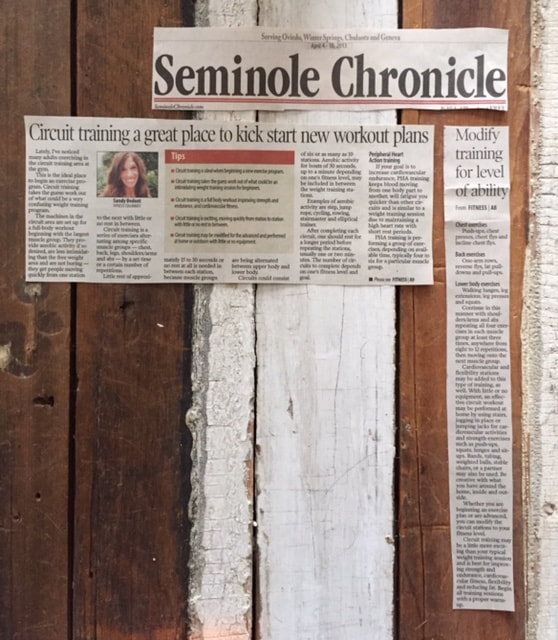
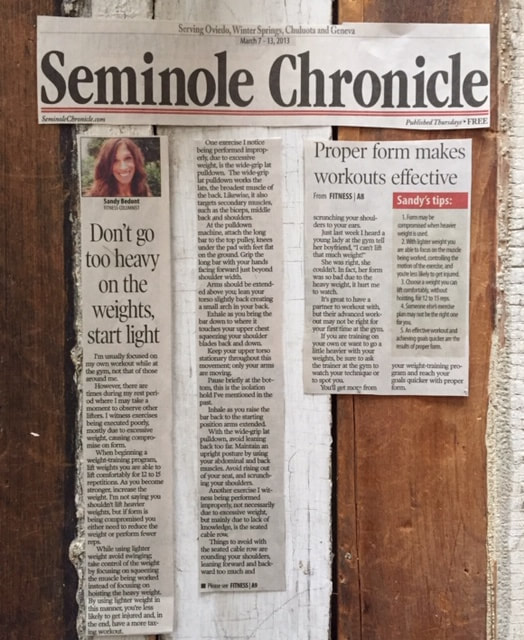

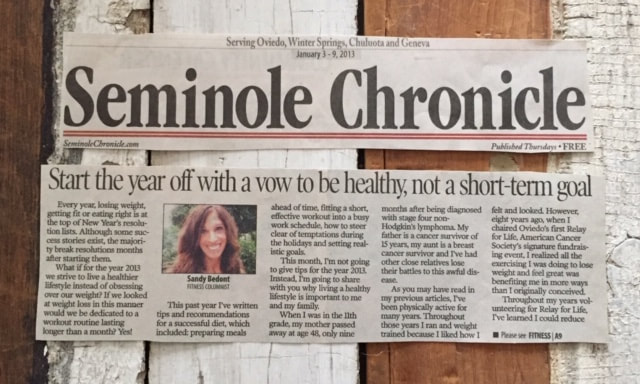
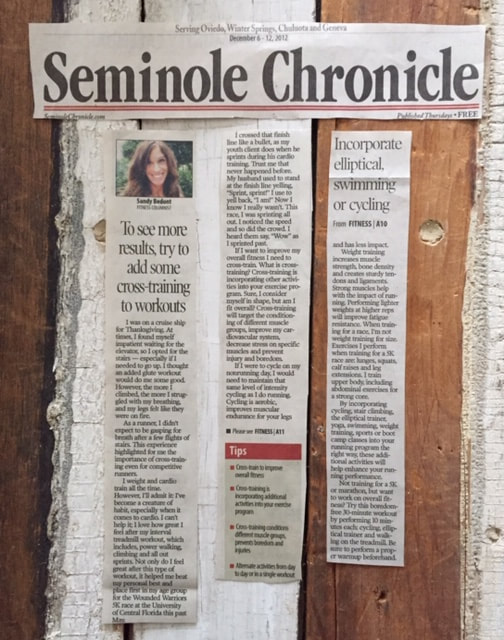



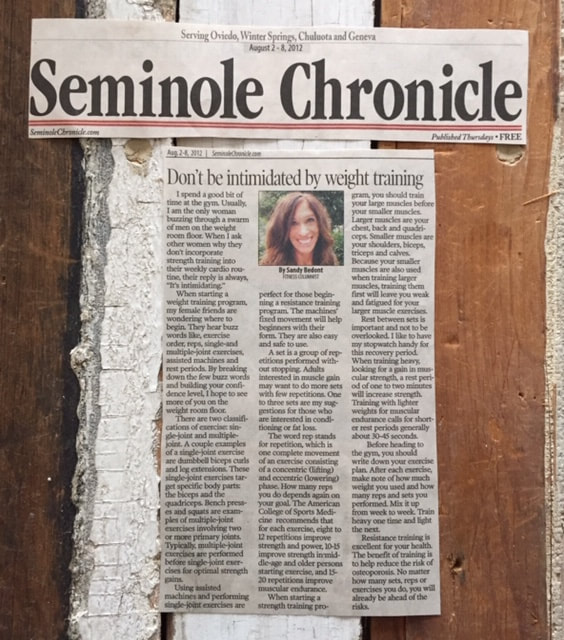
 RSS Feed
RSS Feed